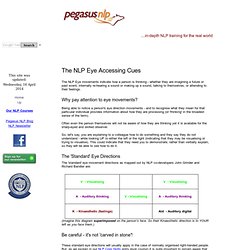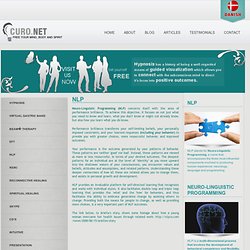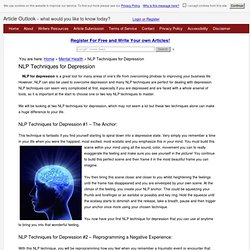

Www.fordummiespdf.com/wp-content/uploads/BusinessNLPForDummiesfreepdfdownload_A10E/NLP.Business.NLP.For.Dummies.pdf. Some books about Neuro-linguistic Programming (NLP) If you have not encountered NLP (Neuro-linguistic Programming) before the following books can be an introduction to the subject.

However do bear in mind that NLP is about discovering and changing how you and other people think, feel and act. Information gleaned from books is interesting but is only part of the story since NLP is about what you do with what you know and not just what you know. This is quite different from the traditional learning process of reading, understanding and memorising. Nlp-eye-accessing2.gif (728×607) NLP Eye Accessing Cues. The NLP Eye movements indicate how a person is thinking - whether they are imagining a future or past event, internally re-hearing a sound or making up a sound, talking to themselves, or attending to their feelings.

Why pay attention to eye movements? Being able to notice a person's eye direction movements - and to recognise what they mean for that particular individual provides information about how they are processing (or 'thinking' in the broadest sense of the term). Often even the person themselves will not be aware of how they are thinking yet it is available for the sharp-eyed and skilled observer. Modeling excellence: fast-track to success or reckless road to ruin?
Open any book on success, personal development or self-help and, without fail, you’ll find a section on “modeling success.”

There, you’ll be told to find people who’ve done what you’ve done, study how they did it, then replicate their thoughts, steps and actions. Toronto. Neuro-Linguistic Programming (NLP) concerns itself with the area of performance brilliance.

To achieve this objective, it focuses on not just what you need to know and learn, what you don't know or might not already know, but also how you learn what you do know. Performance brilliance transforms your self-limiting beliefs, your personally imposed constraints, and your learned responses (including your behavior) to provide you with greater choices, more resourceful behavior, and improved outcomes. Your performance is the outcome generated by your patterns of behavior. These patterns are neither 'good' nor bad'. Instead, these patterns are viewed as more or less resourceful, in terms of your desired outcomes.
NLP provides an invaluable platform for self-directed learning that recognizes and works with individual styles. The link below, to Arielle's story, shows some footage about how a young woman overcame her health issues through related work: NLP Techniques for Depression. NLP for depression is a great tool for many areas of one’s life from overcoming phobias to improving your business life.

However, NLP can also be used to overcome depression and many NLP techniques are perfect for dealing with depression. NLP techniques can seem very complicated at first, especially if you are depressed and are faced with a whole arsenal of tools, so it is important at the start to choose one or two key NLP techniques to master. We will be looking at two NLP techniques for depression, which may not seem a lot but these two techniques alone can make a huge difference to your life.
NLP Techniques for Depression #1 – The Anchor: This technique is fantastic if you find yourself starting to spiral down into a depressive state. You must build this scene within your mind using all the sound, color, movement you can to really exaggerate the feeling and make sure you see yourself in the picture! Methods of neuro-linguistic programming. The methods of neuro-linguistic programming are the specific techniques used to perform and teach Neuro-Linguistic Programming, a movement which teaches that people are only able to perceive a small part of the world using their conscious awareness, and that this view of the world is filtered by experience, beliefs, values, assumptions, and biological sensory systems.

NLP argues that people act and feel based on their perception of the world rather than the real world. Internal 'maps' of the world[edit] Neuro Linguistic Programming, NLP and hypnosis. Using Neuro-Linguistic Programming in the Interview Room - F B I Law Enforcement Bulletin - August 2001 Issue. From the F B I Law Enforcement Bulletin - August 2001 Issue Contributors' opinions and statements should not be considered an endorsement by the FBI for any policy, program, or service. Subtle Skills for Building RapportUsing Neuro-Linguistic Programming in the Interview RoomBy VINCENT A. SANDOVAL, M.A., and SUSAN H. ADAMS, M.A. Mark Hamilton, a seasoned detective, slowly opens the door to the interview room. The witness to the drive-by shooting sits leaning forward in a chair with her head in her hands. If an investigator observes that a witness consistently looks up at an angle, particularly when responding to questions that require recall, the interviewer can conclude, with a measurable degree of confidence, that the person is “seeing” a picture while remembering information.
A Simple Secret To Remember Anything. Learn to Pick Locks for Fun and an Increased Understanding of Security. Illusion of a dragon. SCHOPENHAUER'S 38 STRATAGEMS, OR 38 WAYS TO WIN AN ARGUMENT. Arthur Schopenhauer (1788-1860), was a brilliant German philosopher.

These 38 Stratagems are excerpts from "The Art of Controversy", first translated into English and published in 1896. Carry your opponent's proposition beyond its natural limits; exaggerate it. The more general your opponent's statement becomes, the more objections you can find against it. The more restricted and narrow his or her propositions remain, the easier they are to defend by him or her.
Use different meanings of your opponent's words to refute his or her argument. (abstracted from the book:Numerical Lists You Never Knew or Once Knew and Probably Forget, by: John Boswell and Dan Starer) The Open Organisation Of Lockpickers. This is a repository of the most up-to-date versions of Deviant's lock diagrams and animations.

Seen in all of the TOOOL educational materials and slide decks, these files are all released under the Creative Commons license. You are free to use any of them for non-commercial purposes, as long as they are properly attributed and the same freedom for others is maintained in all derivative works. Please note that these diagrams have evolved and developed over time. While Deviant is still proud of the older versions of his images, if you still have copies of legacy material they should all be replaced with the latest versions available here. Each image shown below in thumbnail form can be accessed in high resolution individually, or you can obtain the full set from the zip archive at the bottom of this page. Barnum effect.